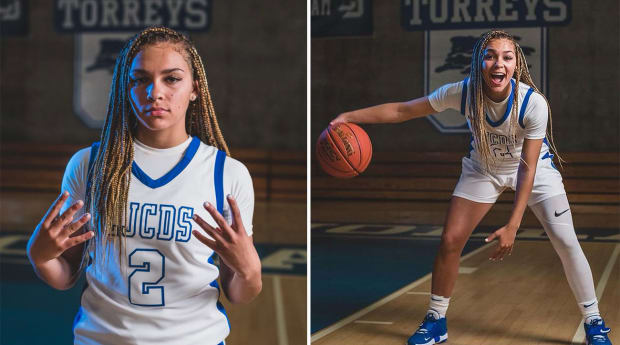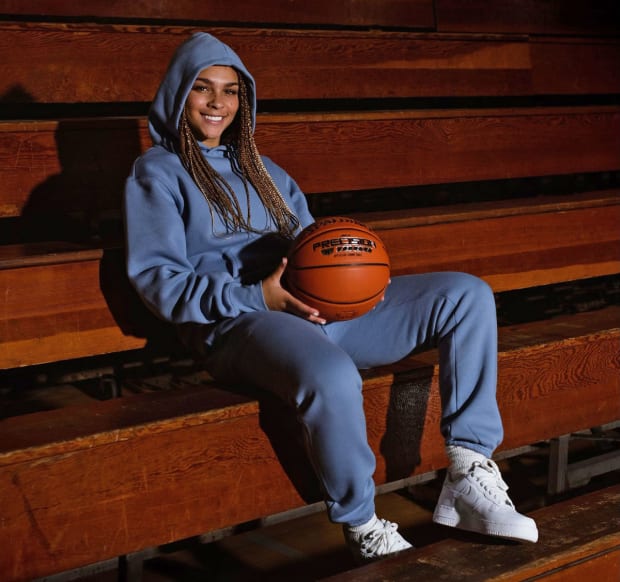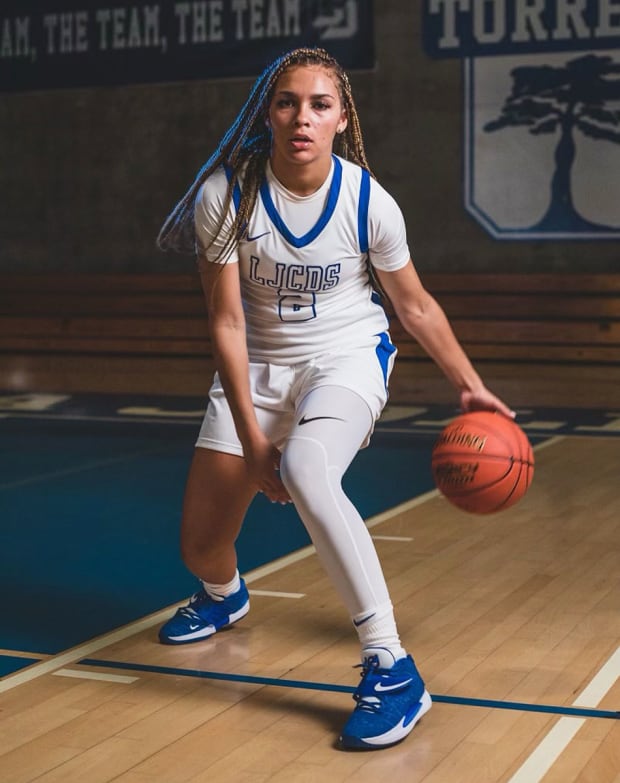High school athletes were historically not allowed to profit off their NIL—and most still can’t. But a 16-year-old star is among the first to change that.
A star, buoyed by the new landscape created by name, image and likeness (NIL), is about to shine a brighter light on girls and women’s basketball—and could help spur change for the future.
Jada Williams is a 5'6" point guard ranked in the top 20 in her 2023 class, according to ESPNW’s HoopGurlz recruiting rankings. In August, Williams helped lead the USA women’s under-16 national team to the gold medal in the ’21 FIBA Americas U-16 championship. She was named to the all-tournament team and led all players in assists per game and three-point shooting percentage while averaging 11.7 points. The Kansas City native has committed to UCLA for college.
Williams recently signed endorsement deals with Spalding (she appears in a commercial alongside Portland Trail Blazers star Damian Lillard) and Dick’s Sporting Goods, among others, and there are even bigger deals in the works, according to Marcus Crenshaw, founder and CEO of The Fam sports agency and marketing company, which represents Williams.

Courtesy of TSC Sports
Such deals are new even for the NIL concept, which went into effect in the NCAA on July 1, 2021. While college athletes like Alabama quarterback Bryce Young and UConn point guard Paige Bueckers have signed major endorsement deals under the college NIL rules, Williams is believed to be the first high school girls basketball player to sign with a national brand. The only other high school athlete with comparable national NIL deals is Mikey Williams, the class of ’23 basketball sensation currently attending Vertical Academy in Charlotte.
“Jada is the first reported female high school basketball player in the country to get a name, image and likeness deal,” said Peter Schoenthal, CEO of Athliance, an NIL opportunity management software platform.
“I think it’s an unbelievable thing,” he continues. “We’ve already started seeing men’s basketball and men’s athletes at the high school level getting NIL deals. It’s awesome to see women also having the ability to cash in and promote themselves from an NIL standpoint.”
But as Williams and her family learned last year, while the NIL craze sweeps across college sports, things operate very differently right now at the high school level.
Basketball exploits and fame are nothing new to Jada Williams. In fact, it has been documented publicly for years. She’s long been an internet and social media darling, amassing more than 340,000 followers on Instagram and more than 120,000 on TikTok, and she’s featured in a litany of viral highlight videos on YouTube. It started years ago.
Crenshaw first posted a video of Williams playing basketball in 2016, when she was 11, to his site, She Hoops Network, which he later sold to the sports content platform Overtime.
“When I used to post her [videos], everybody used to have something to say, so I knew she already had the game, the marketability, the swag and the handles,” Crenshaw says.
“[My social media following] came about, really, I was just having fun. I was doing fun stuff in the gym and I just started posting it and people just started liking it,” Williams says. “That’s when Overtime women’s basketball, She Hoops Network and all that started, and they picked up on it and it kind of rose from there. I was having fun more than anything; I wasn’t trying to get all these followers. I was just being myself, having fun with the people that enjoyed seeing me, just interacting with people. It was fun for me—it’s still fun for me—that’s just what I love to do, I love to talk to people,” she says.
Social media stardom is often looked at with suspicion nowadays, and maybe rightfully so. Many coaches in the sport bemoan the thirst for superficial acclaim online rather than the methodical hard work and dedication away from the cameras needed to become a true master of one’s craft. Williams is viewed differently because of the organic way her social media fame came about and her unquestionable focus and work ethic when it comes to basketball.
“We didn’t plan for any of [the social media fame]; we really never have,” Williams’s mother, Jill McIntyre, says. “I think people think that we’ve spent millions of dollars in marketing and that’s where we’re at; it’s really not. It just happened, you know, we were at the right place at the right time.”
McIntyre also attributes much of her daughter’s online celebrity to Marcus Walker, one of Williams’s longtime trainers and founder of Grindhouse Basketball.
“[Walker] loved to put things on social media, so just naturally him and Jada put their journey out there every single day, and people started to follow it,” McIntyre says.
Beyond the social media attention, what stands out is Williams’s dedication to basketball.
“The simple answer is just work,” Williams says when asked how she’s gotten to this point. “Work and my faith. There’s no replacement for work. Work in the dark, work in the light, do whatever I got to do, by any means necessary. I have my goals, and that’s what’s on my mind 24/7.
“I’m very passionate, as you can see,” she continues. “I’m passionate about a lot of things, but one of those things would definitely be basketball. And from a young age I told myself that this is what I wanted to do, so I’m going to put my 100% in it.”
Those that have worked with Williams along the way have also witnessed her unwavering dedication.
“I can’t remember exactly what year, maybe second or third grade,” McIntyre recalls. “I remember telling her—because I was a single mom at the time—‘hey, if you’re going to be doing this kind of activity every single day and I’m going to make sacrifices, I’m going to match your intensity. Whatever you put into this is what I’m going to match.’
“We laugh at this now, because matching her intensity has been a lifelong commitment,” she says, laughing. “I’m in for way more than I bargained for. I never dreamed what that commitment was actually going to look like on my part.”
Betty Lennox, the sixth pick in the 2000 WNBA draft and an ’04 WNBA champion and Finals MVP, was the first person to train Williams as a young girl. “You know a lot of kids have great potential and skill set, but you don’t have those who have the work ethic behind the skill set. She had all of that, and that’s what attracted me to her,” she says.
Lennox believes Williams is just scratching the surface right now. “I think her potential for the game is literally, the sky’s the limit,” she says. “Why? Because of her work ethic. Second, because of her determination, her mental [toughness], her focus. A lot of players probably could have more development and skill set than Jada, but what makes Jada five or six steps ahead of those other people is her work ethic, her dream, her drive. She loves this game; she really defines the game of basketball. She wants to go out and compete, and it’s something she’s always wanted to do from a young age.”

Ty Rogers
Williams has also been blessed with a supportive and smart team and family around her. They have balanced game play and training schedules on the court and kept her thoroughly grounded and thoughtful off the court.
Chris Meadows, longtime player development coach, family confidant and author of the instructive book I Am D-1, How to Conquer the World of Travel Basketball, believes Williams’s family and team have given her an extra advantage.
“Her team got it right from the start. They always kept long-term goals; they never were trying to be the No. 1–ranked player. Instead, they were trying to just improve and be a good person,” Meadows says. “So, when you improve every day and you’re working towards this long-term goal, that’s always going to win out in time.”
Fast forward to 2022 and all of the work Williams put in has paid off—literally—and much earlier than anyone anticipated.
Name, image and likeness have always been an NCAA construct. It was formally introduced in the California legislature in 2019 to prohibit schools from punishing athletes who accept endorsement money while in college. Despite the now-obvious ramifications, its effect on high school athletes was never seriously contemplated or debated in the public sphere. Would high school athletes be permitted to take advantage of the same endorsement opportunities allowed by the proposed NIL laws without losing college or even high school eligibility?
Various state laws allowing such activity that took effect last summer forced the NCAA’s hand. But the impact the NCAA’s decision and the various state laws will have on high schoolers remains unclear to some extent.
Currently, only six states—California, New York, Nebraska, New Jersey, Alaska and Kansas—allow all high school athletes to sign NIL deals. However, universities and colleges seem to be treating their high school recruits in the same manner they would an enrolled student: What is permitted for current athletes regarding endorsements and eligibility is permitted for future athletes.
Last March, Williams committed to UCLA to play basketball. After the NCAA approved NIL, Williams knew she would have the opportunity to take advantage of it once she reached college. However, the opportunities arose much sooner than she or her mother foresaw.
Multiple companies reached out to McIntyre in the summer about possible NIL deals for the 16-year-old Williams. McIntyre hired lawyers who researched whether such deals would be legal in Missouri. They determined that Missouri law prohibited NIL deals for its high school athletes.
McIntyre found the opportunities so enticing that she felt it would be worth moving her daughter and possibly the family to another locale—one where Williams would be permitted to profit off her likeness, allowing her to begin to secure her financial future.
Eventually, McIntyre learned that California permitted high school students to take advantage of NIL opportunities without jeopardizing eligibility. Soon McIntyre decided to remove Williams from Blue Springs High School in Missouri and enroll her at La Jolla Country Day School. McIntyre then abruptly moved her entire family to San Diego.
“We literally moved out here without anything, and our stuff came probably a month later. So, that’s how quick everything moved and we made it work, so here we are,” she says.
Since arriving in California, Williams has signed at least four NIL deals, including the Spalding deal. McIntyre says they are working within the parameters of state law, as well as NCAA rules, with the help of the UCLA compliance department.
“UCLA has been phenomenal with us in helping us navigate these waters,” McIntyre says. “Jada’s not even on their campus and they’ve helped her out so much, giving us different rules that she can’t break, that have to do with college.”
While things seem to be working out pretty well for Williams and her family now, moving halfway across the country was not something they wanted to do and not something they want other families with star high school athletes to have to do.
“Jada got a lot of backlash for moving from Missouri to California,” McIntyre says. “You know, people back home thinking, ‘Oh, she’s Hollywood now; she doesn’t care about Missouri.’ I don’t think any of them really understand the depth of even why she left. But literally it was to make a stance to hopefully allow all these girls and boys across the United States to be able to use their name and likeness, because obviously by her doing it in California, she knows that’s going to open doors across the world for other girls behind her.”

Courtesy of TSC Sports
If things don’t change, more families will face decisions like the one Jada Williams faced to take advantage of these opportunities. Last year, five-star quarterback recruit Quinn Ewers opted to skip his senior year of high school and enroll early at Ohio State because his home state of Texas did not allow high school athletes to profit off their NIL.
Crenshaw believes other states will change their tone soon.
“They are going to have to open the floodgates,” he says. “There’s going to be too much pressure. When you keep having All-Americans like Jada or Mikey and these players keep transferring to California, coaches are going to start saying, ‘Hey, man, wait a minute. I don’t want to keep losing all my good players just because they’re worth money; let’s open this up.’”
Schoenthal agrees, believing all states will soon allow high school athletes to benefit from NIL.
“I see it in the lens of why the NCAA was forced into doing it,” he says. “In today’s day and age with social media, we realize that marketability is not tied to performance; it’s tied to marketability. I think if you have one hundred, two hundred, three hundred thousand followers, you should be able to profit off of your name, image and likeness as an athlete, just like any other social influencer would. You should not be treating college athletes any different from their peers. So that goes in line with a lot of high school athletes that have one hundred thousand followers, to allow them to do the same thing that their classmates would be doing—and are doing, if they had the same amount of followers.”
Change does seem inevitable, and Williams fully embraces being a trailblazer for future basketball players who wish to take advantage of their hard work and talent and control their own financial destinies at an early age—just like a child actor, musician or a young professional tennis player can do.
“I think [my NIL deals] are super important because it’s always been the NBA players that get it first, and then the WNBA come later getting less money,” Williams says. “Me and my guy Mikey [Williams], who’s also in my class and on the boys’ side, we’re traveling unmarked territory. Whatever we do is going to trickle down the system because we’re first. We’ve been talking about what can we do to let other people know that this is in our hands now.
“I think the main thing is just me leading by example,” she continues. “Once I posted [my deal with Spalding] everyone was like, ‘Oh, my gosh, like, this is actually happening; we can start doing this.’ So I’ve just been telling people to start now. Don’t wait for college to actually do stuff; start now. You have to have a plan; you have to have people in your circle that you can trust. There’s a lot that goes into it, but my main goal is to just lead by example and let people know that it’s possible. There is no impossible; you can do whatever you want. Whatever your dreams are, you can accomplish that.”
Williams also plans to follow in the footsteps of her WNBA mentors by using her platform to shed light on social justice issues and help other people.
“Right now there’s a lot of social inequality and so much with police brutality, etc., so that’s something I’m working on and then just my faith,” Williams says. “My purpose in life is to help other people find their purpose. A lot of people follow me and love my basketball, but at the end of the day, if I post a Bible verse, they’re all like, ‘Can you talk about this on [Instagram] Live?’ That’s what makes me smile; that’s the good part of social media. During the George Floyd protests I touched a lot of people. And when they see people that they look up to being an activist and using their platform, using their voice and not staying quiet, I think it’s important because everyone else is like, ‘I can do that, too,’ because sometimes it’s scary.”
Williams’s reach and influence is already impressive, but all signs point to it continuing to grow.
“It’s only going to get bigger,” says Crenshaw, whose agency represents multiple WNBA players. “There’s not a lot of times when someone this marketable comes along. She understands how to communicate with people and also she’s got the game, she’s a point guard, she’s got the swag, LeBron [James] went to see her play; she’s a whole attraction. She’s special for women’s basketball. There’s not going to be too many Jada Williams that can do what she’s doing as a junior [in high school]. She’s special.”
Williams is at the beginning of her journey, and she has a ways to go before attaining all of the goals she has set for herself and reaching the expectations placed on her by others. But she seems as poised as any 16-year-old phenom could be in her pursuit.
“Right now I’m really focused on just becoming a better point guard and having a good season at my new high school. I think we’re going to be very, very good, and I think I’m in the right spot,” she says.
As for how she stays focused despite the pressure, she keeps it simple.
“Two things, my family and my Bible. My family keeps me grounded; when I come home it’s normal. They’ve been there since Day One.”
More Basketball Coverage:
• The Drive That Fuels Johnny Davis, Breakout Star
• Indiana WBB Has Much More It Wants to Prove
• SBLIVE/SI Power 25 National Boys Basketball Rankings